Can You Tile Over Drywall? In Most Cases, Yes
Author: Rick Worst | Editor: Omar Alonso
Review & Research: Jen Worst & Chris Miller

You finish installing the drywall, and it looks great. Now, the next task is to hang the tiles. But can you tile over drywall? Or will the tiles just fall off? Good news. In most cases, you can tile over drywall, but in some cases, you can't.
If you're tiling over drywall in areas where it's dry, then tiles will generally hold fine. It might not be such a good idea if you're tiling over drywall in humid areas, like the bathroom. So, it depends on the environmental conditions in the room.
You should avoid tiling in areas like the bathroom because there's a chance mold could start growing behind the tiles, presenting a health risk. Or it could get behind the tiles and cause damage or rot in the drywall. However, in most instances, it's fine to tile over drywall, and you won't have any problems.
Can You Tile Over Drywall?
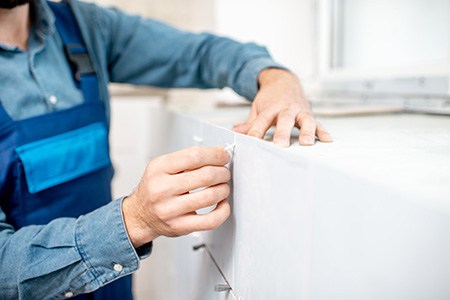
Tiling over drywall is suitable for most areas in the home with most types of tile. While the general rule of thumb is to avoid tiling in areas exposed to high moisture levels, you can bend this rule in some exceptions. For instance, tiling over a drywall backsplash on the kitchen counter is usually fine and won't present problems.
The key to preventing damage or mold growth behind the tiles is to properly prepare the drywall before tiling, and to use a suitable mortar for the project. Most contractors will drywall over tiles and rely on proper surface preparation to ensure they do a good job.
The only places in the home where you can't tile over drywall are in areas continuously exposed to moisture or high humidity. For instance, hanging tiles over drywall in the shower stall isn't a good idea. Likewise, hanging tiles on the drywall in a sauna or an outdoor kitchen isn't optimal and could end in disaster.
You must be aware of the risks when tiling over drywall in these areas. For instance, tiling over drywall in the laundry room or behind the sink is usually a no-go. However, using a tile sealer to protect the tiles and drywall will decrease the chances of anything going wrong.
Tiling over drywall presents a safety risk in some instances. If you don't properly prepare the drywall for tiling, you could end up with water creeping behind the tiles causing issues with the installation.
If you're tiling over drywall in the bathroom, relative humidity levels in the room can reach elevated levels. So, you'll need to install them on a cement board or a tile backer suitable for use in wet areas. Even better, you can glue a tub surround over the existing tile to seal it off even more, especially in the shower or around the tub.
Can You Tile On Drywall in Wet Areas Around the Home?
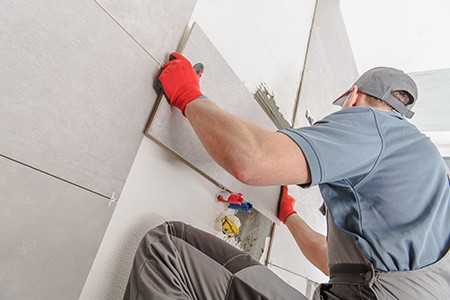
Can you tile over drywall? Yes, but sometimes tiling over drywall in the bathroom or other wet areas around the home isn't against the building code. However, you'll need to understand the following safety risks involved with the project.
Rot & Damage
If moisture gets behind the tiles due to improper preparation of the surface, it can damage the wood behind the drywall, causing structural problems and rot.
Mold Infestation
Mold likes growing in dark, wet areas, and you'll eventually notice the tiles start to feel like the wall behind them is soft.
Pest Infestations
Termites and carpenter ants will take advantage of the moisture behind the tiles and use it as a water source.
Unfortunately, most of these issues happen out of sight. That means you won't notice them until they become huge problems. In most cases, you won't realize you have a problem until it's out of control. For this reason, contractors don't like tiling over drywall in wet or humid areas around the home.
Use Cement Board for Tiling in Wet or Humid Areas
If you want to tile in wet areas, using a backing system like cement board is a better drywall alternative. These boards are similar to drywall in that they come in sheets. However, the cement board doesn't deteriorate like drywall when exposed to water and won't develop mold.
You'll install the cement board the same way as drywall, with a few differences. First, you'll use a vapor barrier behind the cement board to stop moisture from creeping in. Second, you seal the seams with water-resistant tape.
Preparing Drywall for Tiling
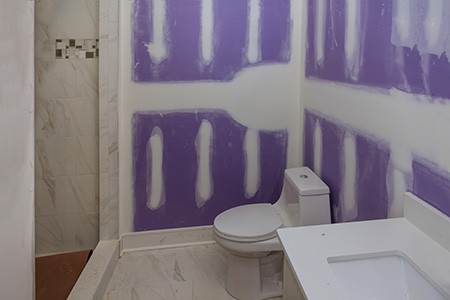
Proper preparation of drywall is essential for hanging tiles on the surface. Fortunately, these preparation methods don't require much more effort than they do before painting. If you want to do the job right, you need proper preparation and an investment of your time. Cutting corners will only result in poor results and eventual ruining of the drywall and the need for repairs.
Can you tile over drywall? For sure, but you'll need to prep bare drywall for hanging tiles using the following method:
- Ensure proper sealing of all the seams in the drywall.
- If the seams require sealing, apply a skim coat over the entire section of the wall rather than focusing on creating perfect seams.
- Sand down any rough areas on the drywall. You need a smooth, flat surface for proper adhesion of the tiles. Otherwise, you'll end up with bumpy tiles if the surface doesn't have the right consistency.
- Eliminate dust in the work area by vacuuming and cleaning thoroughly before starting the project. Use a damp cloth to wipe the wall and remove dust or debris.
- Paint primer on the wall for better adhesion. This task seals the drywall, protecting it from moisture. It also assists with smoothing the wall for the optimal hanging of the tiles.
- Cure the primer completely before hanging your tiles.
Following the above steps will ensure you have the greatest success with tile on drywall.
What Mortar Is Suitable for Tiling Over Drywall?
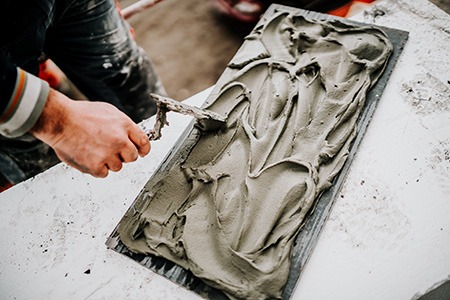
We recommend you use thin-set mortar when hanging tiles on drywall. This material is especially important if you're hanging drywall in areas that could get wet, such as in a kitchen backsplash.
You could get away with using a mastic, but it's not a good choice for areas that get wet or experience heavy moisture. So, why risk using mastic when you can use a thin-set? Applying the thin-set doesn't require any extra effort, just good planning.
Preparing Painted Drywall for Tiling
Hanging tiles on drywall is slightly different if the drywall is already painted. Follow these steps to properly prepare painted drywall before hanging your tiles:
- Clear the area before tiling.
- Remove light switch faceplates and outlet covers, and trim where necessary. You want these fixtures to sit on the tiles, not underneath them.
- Use TSP to clean the wall. TSP scrubs away build-up and grease from the surface, making it easier for the tiles to adhere to the drywall. Ensure the surface is dry before moving on to the next step.
- Sand imperfections and fill holes in the drywall to provide a consistent and even surface for the tiles. You don't want defects that might cause the tiles to hang unevenly.
- If you used spackle or joint compound to patch the drywall, sand it down and clean the repaired area using a damp cloth. Allow the wall to dry completely before moving on to the next step.
- Paint or prime the wall before installing the tiles. Scuff the primer or paint using sandpaper to ensure a stronger adhesion of the tiles to the drywall.
- If you installed new drywall, wait at least four weeks before hanging tiles. Give the plaster enough time to set correctly before starting the tiling job.
Tile over painted drywall is fine as long as you scuff the paint to create a surface the mortar can adhere to.
FAQs Regarding Tile on Drywall
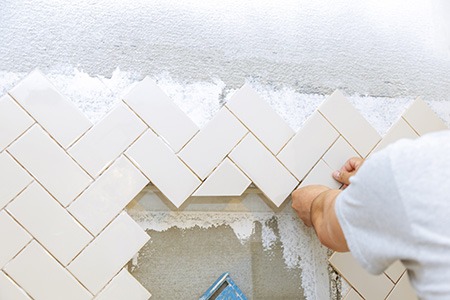
Can you tile over sheetrock? You can. But that only says so much. What about all of the other questions arising in your mind regarding some of the details? Let’s look at those now.
Can You Fit Large Tiles to Drywall?
Yes. You can fit large tiles to drywall without any problems. The recommended load capacity for drywall is 15 pounds per square inch. Most large tiles are well below this weight threshold.
How Do You Waterproof Drywall Before You Start Tiling?
Before hanging tiles, you can prime drywall using a liquid-based waterproofing membrane. The primer replaces the need for dampening the substrate with water for a Saturated Surface Dry (SSD). The primer also prevents the drywall from sucking the hydration out of the thin-set bonding coat, preventing it from curing too fast.
How Do I Know if the Wall is Drywall?
You can use the pushpin test to check if the wall is drywall. Press a pushpin onto the drywall with your thumb. If the pin penetrates the wall easily, it's drywall. If it takes effort, it's plaster.
Key Takeaways for Tile Over Drywall
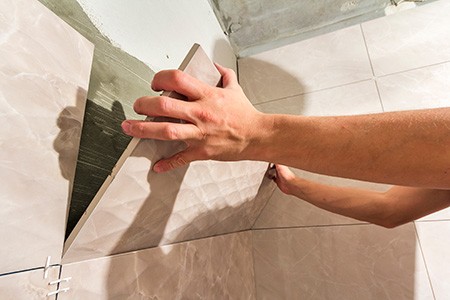
- Yes. You can tile over drywall.
- Don't tile over drywall in spaces around the home exposed to water or high humidity.
- Water falling behind the tiles can rot the drywall structure, cause mold growth, or invite insect infestations.
- If you experience problems with insects, water damage, and mold, they'll be severe before they become apparent.
- Damaged, rotted, or moldy drywall requires replacement.
- Using the correct surface preparation techniques, you can hang tiles on drywall, even in wet areas.
- However, it's recommended to avoid hanging tiles on the drywall in wet applications to reduce the risk of replacing the drywall and tiles.
So, Can You Tile Over Drywall or Not?
Can you tile over drywall? Yes, and in fact this is how it’s done in a large majority of cases. You simply need to clean and make sure the surface is rough enough for your mortar to adhere to, and you’ll be fine. This even goes for painted drywall. Fear not, trust the procedure, and you’ll have a great outcome.



